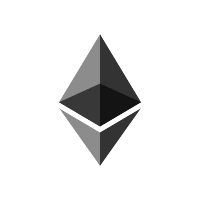The Cancun upgrade has finally arrived. Which targets will benefit?
Later today, Ethereum is expected to officially activate the Dencun hard fork upgrade at Beacon Slot 8626176.
The so-called Dencun upgrade is actually a collective term for the Deneb and Cancun upgrades, with the former focusing on the consensus layer and the latter on the execution layer. The Chinese name for Cancun is the long-awaited "Cancun upgrade" by the Ethereum community.
Before officially landing on the mainnet, Ethereum core developers and major client teams have deployed the Dencun upgrade on Devnet, Goerli testnet, Sepolia testnet, and Holesky testnet over the past few months to test and observe the upgrade and the subsequent network operation status.
Upgrade Content: A total of nine EIPs, focusing on EIP-4844
According to the Ethereum Foundation, this Dencun upgrade will execute a total of nine EIPs (Ethereum Improvement Proposals), specifically:
EIP-1153: About transient storage opcodes;
EIP-4788: About beacon block roots in the EVM;
EIP-4844: About sharded Blob transactions;
EIP-5656: About MCOPY, i.e., memory copy instruction;
EIP-6780: About SELFDESTRUCT in the same transaction;
EIP-7044: About permanently valid voluntary exit signatures;
EIP-7045: About adding the maximum time slot for proof inclusion;
EIP-7514: About adding maximum Epoch loss limits;
EIP-7516: About the BLOBBASEFEE opcode.
For readers who are not very familiar with Ethereum development terminology, you do not need to understand the specific content of each EIP mentioned above; just focus on the most important update of this Dencun upgrade ------ EIP-4844.
EIP-4844, also known as Proto-Danksharding, is a precursor to the current mainstream sharding approach of the Ethereum community, Danksharding. The main content of EIP-4844 (Proto-Danksharding) is to introduce a brand new transaction type "Blob transaction" to Ethereum, by adding an additional temporary data space called Blob in the blocks on the Ethereum mainnet, specifically for handling Layer 2 related transactions, thereby significantly reducing the transaction cost of Layer 2.
Micro Analysis: How does Blob affect Layer 2 transaction costs?
Earlier this week, Ethereum core developer eric.eth stated on the X platform that the implementation of EIP-4844 "will reduce Ethereum transaction fees to $0.01" ------ eric.eth later admitted that this statement was misleading, as he intended to express that the gas cost of Layer 2 transactions in the Ethereum ecosystem would drop to around $0.01.
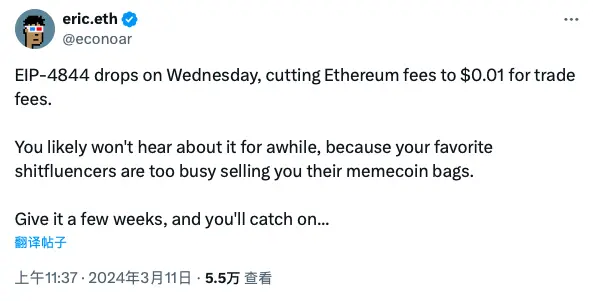
So, how exactly do "Blob transactions" help Layer 2 achieve cost reduction and efficiency improvement? After the upgrade, can the transaction costs on Layer 2 really be reduced to the extremely low level of $0.01?
To answer these questions, we first need to focus on the operational mechanism of Layer 2. Whether it is Optimistic Rollup or ZK Rollup, as long as it narrowly relies on the Ethereum mainnet as the DA layer, Layer 2 will follow the following operational model ------ Layer 2 needs to write its transactions, proofs, and execution results into the calldata data space on the Ethereum mainnet to pass its historical records to Ethereum, relying on the latter to ensure the decentralization and security of the network.
This data synchronization model relying on calldata has been running stably for a long time, but there has always been a serious problem ------ The calldata write transactions submitted by Layer 2 need to compete in the same fee market with all transactions on the Ethereum mainnet, which causes the transaction costs of Layer 2 to be significantly affected by the gas conditions of the Ethereum mainnet.
To ensure that calldata write transactions can be executed smoothly on the Ethereum mainnet, Layer 2 will pass this part of the cost onto users executing transactions on Layer 2. Currently, the costs for calldata write transactions account for a large proportion of Layer 2 transaction costs, which is why users generally feel that the current transaction costs on Layer 2 are still too expensive.
After the implementation of EIP-4844, Ethereum will add an additional data space called Blob in the blocks, specifically for handling Layer 2 related transactions. At that time, Layer 2 will no longer need to write data into the calldata space; instead, it will use the Blob space to complete data synchronization operations. Additionally, subsequent Layer 2 related transactions will be distinguished from other Ethereum mainnet transactions as two independent fee markets, no longer interfering with each other.
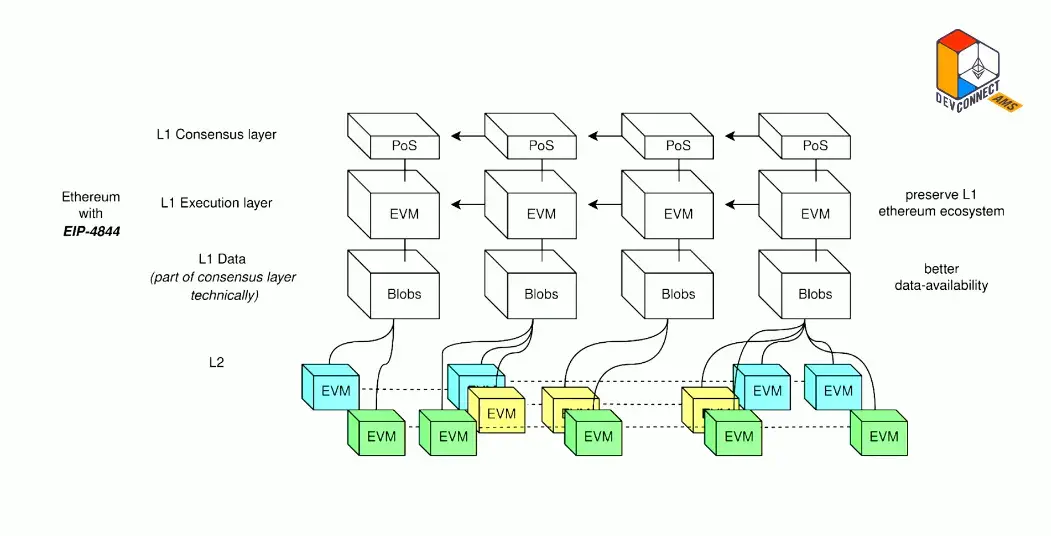
It is worth mentioning that to prevent the additional Blob data space from placing too much burden on Ethereum mainnet nodes, the data within the Blob will be periodically cleared, which also means that the historical data storage mechanism of Layer 2 will undergo some new changes in the future.
Based on the above analysis, it can be expected that after the implementation of EIP-4844, the data synchronization costs of Layer 2 networks will significantly decrease, thereby indirectly lowering the transaction costs for users on Layer 2 networks; in addition, as the block space previously occupied by Layer 2 is released (transferred to Blob), the fee competition pressure faced by other Ethereum mainnet transactions will also ease, thus EIP-4844 will also reduce the transaction fee costs on the Ethereum mainnet to some extent.
As for how much the transaction costs on various Layer 2 networks will decrease after the upgrade is completed, Optimism has launched a website called welovetheblobs to intuitively query the fee changes for various operations, such as the transaction cost for executing a swap on Velodrome will decrease from the current $0.52 to $0.03.
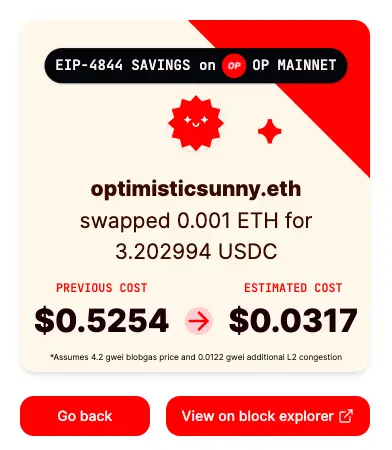
Beneficial Targets: What else besides Layer 2?
For investors, besides understanding the content and role of the Dencun upgrade, the most interesting topic is which potential targets will benefit from this upgrade.
First of all, the Dencun upgrade will naturally directly benefit the entire Layer 2 sector. According to L2 BEAT data, there are currently as many as 45 operational Layer 2s, and 34 Layer 2s are waiting to go live on the mainnet, including well-known projects like Optimism (OP), Arbitrum (ARB), Starknet (STRK), Metis (METIS), Manta Pacific (MANTA), as well as unlaunched projects like zkSync, Blast, Linea, and Scroll.
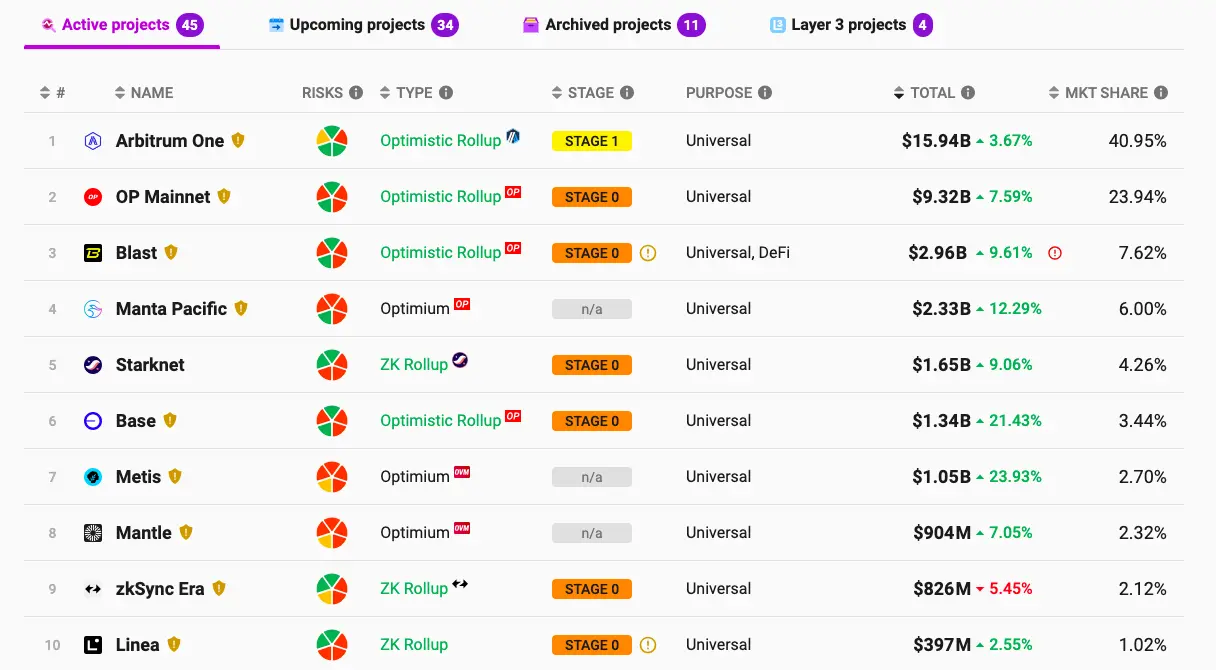
With the implementation of the Dencun upgrade, especially EIP-4844, the aforementioned projects and many more Layer 2s will achieve significant "cost reduction and efficiency improvement," enabling Layer 2 networks to level the playing field in terms of transaction costs compared to low-fee Layer 1s like Solana. In the long run, the reduction in transaction friction will help major Layer 2s attract and retain more users, as well as attract more developers for various development attempts, thereby continuously enhancing ecological vitality.
Among the various Layer 2s, zkSync may need special mention, as zkSync founder Alex Gluchowski has mentioned that a new scaling solution called zkPorter will be launched after the implementation of EIP-4844, and zkPorter will rely on zkSync's native token to ensure data availability, which may indicate that zkSync is not far from launching its token.
In addition to directly benefiting Layer 2, the Dencun upgrade will also indirectly benefit other related fields and sectors.
For example, projects on Layer 2 that have "high concurrency requirements" and "low unit value" attributes, such as games and social applications, may experience accelerated growth opportunities. Currently, due to the still high fee costs, the mainstream application types on Layer 2 are still represented by DeFi projects with "low concurrency requirements" and "high unit value," as only such projects can achieve ideal economic effects under higher fee costs. However, with the arrival of the Dencun upgrade, this situation may also see a change.
Furthermore, storage concept projects may also encounter certain development opportunities due to changes in Layer 2's storage needs for transaction history. Since Blob will not permanently store data like calldata, this means that Layer 2 will need to find other paths for long-term storage of historical transaction data, and new demands will create new opportunities.
Additionally, if Layer 2 can further gain market consensus after reducing transaction costs, RaaS-type "water delivery" services may also see increased demand for utilization, but that is a relatively long-term topic.
In summary, as the Dencun upgrade gradually becomes a reality, the overall fundamental situation of the Ethereum ecosystem will undoubtedly see significant improvement, and this benefit will radiate to all components within the Ethereum ecosystem.
In the short term after the upgrade is completed, users may not have many other noticeable perceptions besides the reduction in Layer 2 fees, but in the long run, the potential ecological vitality brought by the Dencun upgrade itself and its foundational role in supporting subsequent upgrades will undoubtedly propel Ethereum into a new stage of development.






